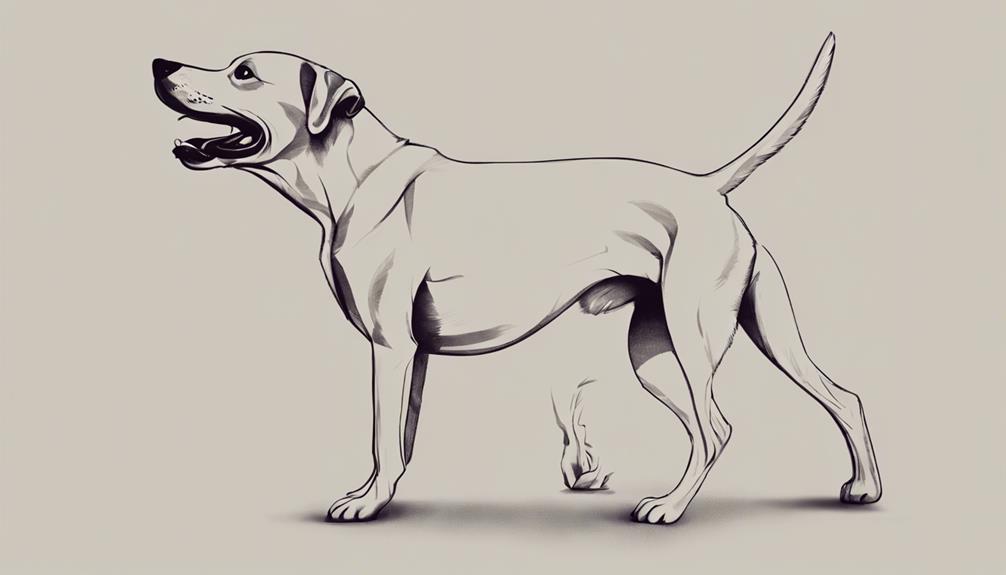Why Should You Learn to Respond to Dog Communication?
When it comes to deciphering the language of dogs, it's like unlocking a hidden code that can deepen your bond with your furry companion. Understanding their cues goes beyond just listening; it's about truly connecting with your pet on a whole new level.
By learning to respond to dog communication, you'll not only enhance your relationship but also ensure your pet's well-being and happiness. Curious to uncover the secrets behind your dog's behavior?
Understanding Canine Body Language
To understand canine body language, pay attention to their tail movements and ear positions. Canine behavior and training heavily rely on nonverbal communication, making it crucial for dog owners to be adept at interpreting these signals.
When a dog's tail is wagging loosely and at a mid-level position, it often indicates a friendly and approachable demeanor. Conversely, a tucked tail suggests fear or submission. Ears that are perked up signify attentiveness or excitement, while flattened ears indicate fear or aggression.
Recognizing Vocal Cues From Dogs
When dogs communicate vocally, their barks, growls, whines, and howls convey a range of emotions and intentions. Reading tone and pitch is crucial in understanding what your dog is trying to communicate. Different pitches or tones can indicate excitement, fear, aggression, or playfulness. Understanding growls and whines is equally important as they can signify various states of mind.
Here are some key points to consider when recognizing vocal cues from dogs:
- Pitch Variations: Pay attention to whether the pitch is high or low, as this can give clues about your dog's emotional state.
- Repetitive Barking: Excessive barking can signal discomfort, boredom, or a need for attention.
- Whining Patterns: Whining can indicate anxiety, pain, or a desire for something.
- Growling Intensity: The intensity of a growl can range from playful to threatening, so observe the context in which it occurs.
Interpreting Tail Wagging Signals
Understanding a dog's tail wagging signals is essential in decoding their emotional state and intentions. Tail language serves as one of the key ways dogs communicate with humans and other animals. When a dog wags its tail, it isn't just a sign of happiness; it can convey a range of emotions and messages. The speed, height, and direction of the tail wagging are crucial in interpreting these communication signals.
Tail wagging can indicate excitement, but it can also signify anxiety, fear, or even aggression depending on the context and other body language cues. A high, fast wag often suggests a positive emotional state, while a slow, low wag could indicate uncertainty or wariness. Pay attention to the accompanying body posture and facial expressions to get a more accurate read on what the dog is feeling. By observing and understanding these tail wagging signals, you can better respond to your furry friend's needs and create a stronger bond based on clear communication.
Deciphering Facial Expressions in Dogs
Deciphering a dog's facial expressions is just as crucial as interpreting their tail wagging signals to understand their emotions and intentions. When observing a dog's face, pay close attention to their ear positions and mouth movements, as these can provide valuable insights into how they're feeling.
- Interpreting Ear Positions: A dog with ears perked up might be alert or excited, while ears flattened against the head could indicate fear or submission.
- Understanding Mouth Movements: A relaxed, slightly open mouth often signifies a content and friendly demeanor, whereas lips pulled back can signal aggression or discomfort.
- Eye Contact: While not the focus of this section, maintaining eye contact is another important aspect of understanding a dog's intentions, which will be discussed in the next subtopic.
- Overall Expression: Combining ear positions and mouth movements with other facial cues can give a more complete picture of a dog's emotional state, helping you respond appropriately to their needs and feelings.
Importance of Eye Contact With Dogs
Making eye contact with dogs is a fundamental aspect of communication that establishes trust and connection between you and your furry companion. When you engage in eye contact with your dog, it fosters a sense of bonding and understanding. Eye contact benefits both you and your dog by conveying feelings of affection, reassurance, and attentiveness.
Through eye contact, you can also pick up on important nonverbal cues from your dog. Dogs communicate a lot through their eyes, and by maintaining eye contact, you can better interpret their emotions and intentions. Additionally, establishing eye contact helps in reinforcing your role as a leader in the relationship, which can lead to improved obedience and cooperation from your furry friend.
Moreover, eye contact is a key component of understanding your dog's body language cues. It allows you to gauge their comfort level, excitement, fear, or even aggression. By being attentive to their eyes, you can adapt your behavior accordingly to ensure a positive and harmonious interaction. So, next time you communicate with your dog, remember the significance of maintaining eye contact for effective and meaningful communication.
Responding to Bark Types
When your dog barks, paying attention to the different types of barks can help you understand their needs and emotions. Dogs use barking as a form of communication, and by interpreting their barks, you can better respond to their vocal cues and behaviors. Here are some key points to consider:
- Bark Interpretation: Different barks may signify various messages, such as alerting you to something, expressing excitement, or indicating fear or discomfort.
- Communication Cues: The pitch, intensity, and frequency of your dog's bark can provide valuable information about their emotional state and what they might be trying to convey.
- Vocal Responses: Engaging with your dog through vocal responses, such as acknowledging their barks with words or sounds, can strengthen your bond and reassure them that you understand.
- Dog Behavior: Observing your dog's behavior alongside their barks can give you a more comprehensive understanding of what they're trying to communicate.
Engaging With Play Bow Gestures

Engage with your dog's play bow gestures to enhance your communication and strengthen your bond. Understanding play behavior is crucial in fostering social interactions with your furry companion. When your dog performs a play bow, with their front legs lowered, hindquarters raised, and a wagging tail, they're inviting you to engage in playful interactions. Responding to this gesture by reciprocating in a playful manner can deepen your connection and build trust.
Play bows are a universal sign among dogs that signify their desire for fun and games. By recognizing and reciprocating this behavior, you not only encourage positive social interactions but also show your dog that you understand their cues. Engaging with play bow gestures can lead to joyful moments, promote physical activity, and boost your dog's overall well-being.
Next time your dog initiates play with a bow, join in the fun! Whether it's a game of chase, tug-of-war, or simply running around, embracing these moments strengthens your bond and communicates to your dog that you value their need for play and social engagement.
Building Trust Through Communication
By responding to your dog's play bow gestures, you lay a foundation for building trust through effective communication. Trust building and communication cues go hand in hand when it comes to fostering a strong bond with your furry companion. Understanding and responding to your dog's nonverbal signals can significantly aid in connection building and create a more harmonious relationship.
Here are some key points to keep in mind:
- Consistency: Consistently acknowledging and responding to your dog's communication cues helps establish a sense of reliability and trust in your relationship.
- Positive Reinforcement: Using positive reinforcement techniques when your dog displays desired communication behaviors reinforces trust and encourages further positive interactions.
- Empathy: Showing empathy towards your dog's communication signals demonstrates understanding and strengthens the emotional connection between you and your pet.
- Active Listening: Actively listening to your dog's cues and responding appropriately fosters a sense of being heard and understood, enhancing the trust between you.
Frequently Asked Questions
How Can You Tell if a Dog Is Feeling Anxious or Stressed?
To tell if a dog is anxious or stressed, watch for body language like trembling or yawning, and listen for vocalizations like whining. Stress signals could include lip licking or avoiding eye contact. Fear indicators may include cowering or tail tucking.
What Are Some Common Signs of Aggression in Dogs?
When a dog is showing signs of aggression, you may notice growling, snarling, or baring their teeth. Their body language and posture can also give clues – a stiff body, raised fur, direct eye contact, and a tense facial expression.
These are warning signs that the dog may be feeling threatened or stressed. It's important to recognize these signals to avoid escalating the situation and to keep yourself and the dog safe.
Can Dogs Communicate Through Scent as Well?
Yes, dogs can communicate through scent. They use olfactory signals to convey information about their emotions and intentions.
By interpreting their behavior and responses to different scents, you can better understand what your furry friend is trying to communicate.
Paying attention to scent communication is crucial for building a strong bond with your dog and ensuring effective communication between you both.
How Do You Distinguish Between a Playful Bark and a Warning Bark?
To distinguish between a playful bark and a warning bark, pay attention to body language and vocal cues. Playful behavior is often accompanied by a wagging tail, relaxed posture, and a higher-pitched bark.
On the other hand, warning signs may include a stiff body, raised fur, and a lower, more intense bark. By observing these cues, you can better understand your dog's intentions and respond appropriately.
Are There Any Non-Verbal Cues That Indicate a Dog Is Feeling Fearful or Intimidated?
When a dog feels fearful or intimidated, their body language can give you clues. They may cower, tuck their tail between their legs, or even tremble.
Avoiding eye contact and turning their head away are also signs of distress. Sometimes, they might whimper or growl softly.
Pay attention to these non-verbal cues to understand and respond appropriately to your furry friend's emotions.
Conclusion
In conclusion, learning to respond to dog communication is crucial for building a strong bond with your furry friend. By understanding their body language, vocal cues, and gestures, you can better communicate with them and meet their needs effectively.
Paying attention to their signals and responding appropriately won't only improve your relationship with your dog but also enhance their overall well-being and happiness. So, take the time to learn and understand your dog's unique ways of communicating—it will be worth it in the long run.
